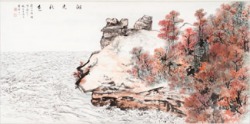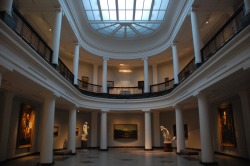
 Last weekend I visited the University of Michigan Museum of Art as a way to escape work, classes, and the dreary weather for a few hours. I mostly visited out of curiosity (to be honest, I wasn't expecting too much from a university art museum), but I was surprised by the diversity of their collection - it's got everything from copies of Greco-Roman statues to Buddhist sculpture, with American landscape paintings and German Expressionist prints thrown in for good measure. While the main exhibits were impressive, my favorite gallery was an exhibition on Chang Ku-nien, an artist who trained in classic Chinese landscape painting in the 20th century. Following the cultural revolution, he fled to Taiwan and he was the first to paint Taiwanese landscapes in the traditional Chinese style. In his later years, he traveled extensively throughout the United States and eventually settled in Michigan, where he began to paint the landscapes of the Upper Peninsula in the traditional Chinese style (see the image below). You can find a link to the exhibition with more examples of his work here. It's not related to public health (well, I could probably find a connection if I really tried...), but the university's art museum represents one of the University of Michigan's great advantages - it's size. The sheer size of the university has two primary consequences: it can have excellent programs in many fields, and it draws world-class speakers (Kenneth Cole and Paul Krugman spoke at UMich last term). For students, the benefits are pretty obvious (free access to the vast majority of these events) and the diversity of the faculty mean that it's never difficult for a student to find an expert. The faculty, at least the ones with whom I've had contact, are willing to help even if you're not from their department. As an example, I'll need to get training from medical school faculty in order to carry out my internship this summer, and to get that training all I have to is walk down the street.
1 Comment
 Yesterday the University of Marburg awarded the first ever Richard Hamann Prize for Art History to Professor Horst Bredekamp, who teaches art history at the Humboldt University of Berlin. I found out about the award somewhat by chance, and decided to attend. The ceremony took place in the main lecture hall of the "Old University" - a 19th Century neo-gothic reconstruction of a 13th Century monastery torn down during the reformation by angry protestants. The lecture hall was quite impressive - neo-Romantic wall panels depict the (not always revolutionary) history of Marburg, with the main center panel given over to the Marburg Colloquy, as well as a very ornate ceiling. Attending the lecture was worth it just for a look inside this room (and the free champagne at the end). The ceremony opened with a short, generic introduction by Professor Volker Nienhaus, the President of the University. It was fairly prosaic and just thanked everyone involved, especially the sponsors of the award - Herr and Frau Ahrens, who started the department store of the same name. As the sponsor, Herr Ahrens was allowed to speak next. He started off with the rather frank admission that he "...knew nothing about art history" and it went downhill from there. By the end of it he was comparing himself to the art patrons of the rennaisance and stating that without the support of businessmen who "enjoy and consume art" then many of the world's great works would not have been produced. To top it all off, for his conclusion he claimed that a department store and a theater were essentially the same, with the prime difference being, "A department store does not sell subscriptions - we have to work harder to sell our wares." His monotone and plodding delivery didn't help matters much. |

 RSS Feed
RSS Feed